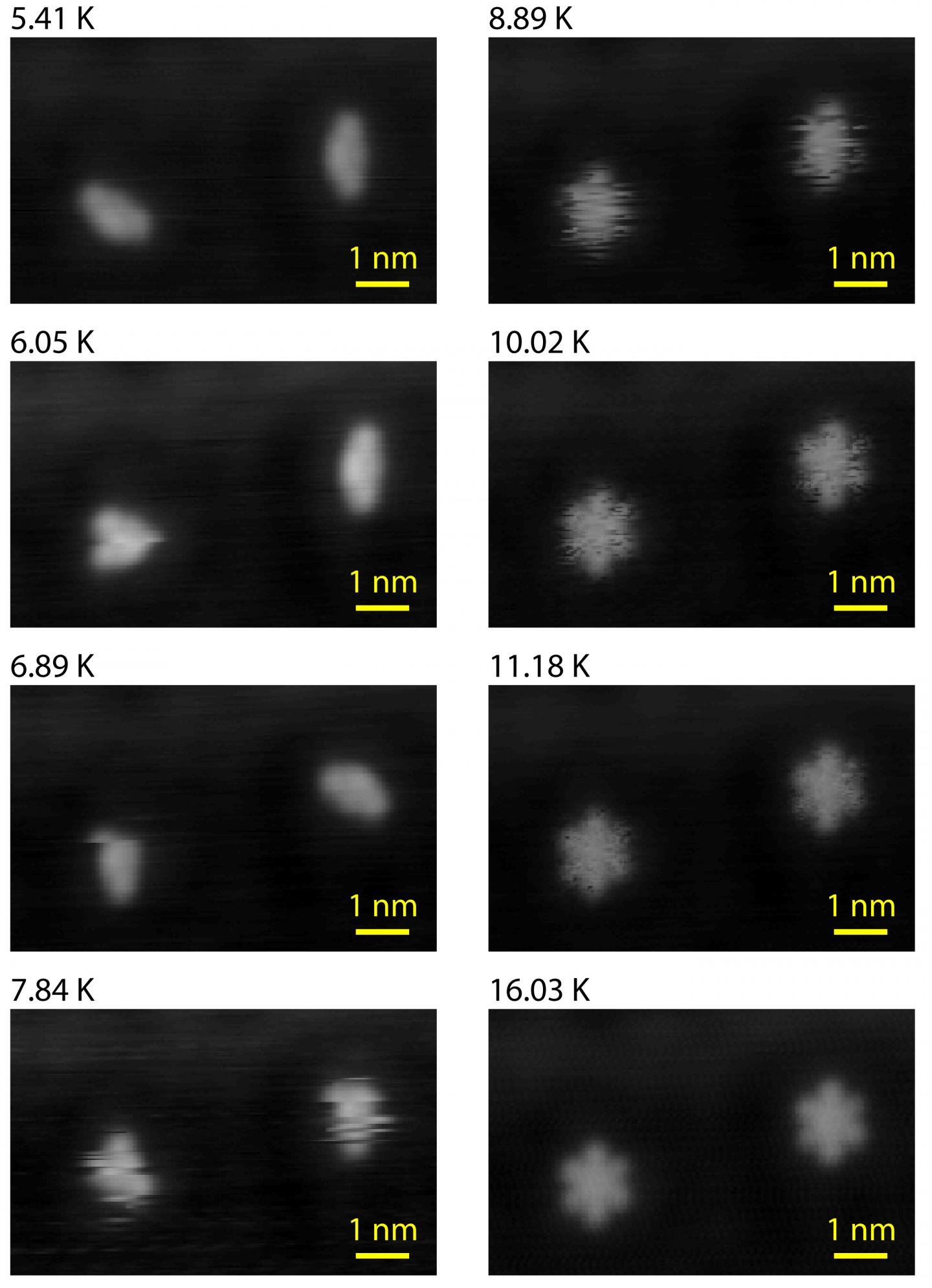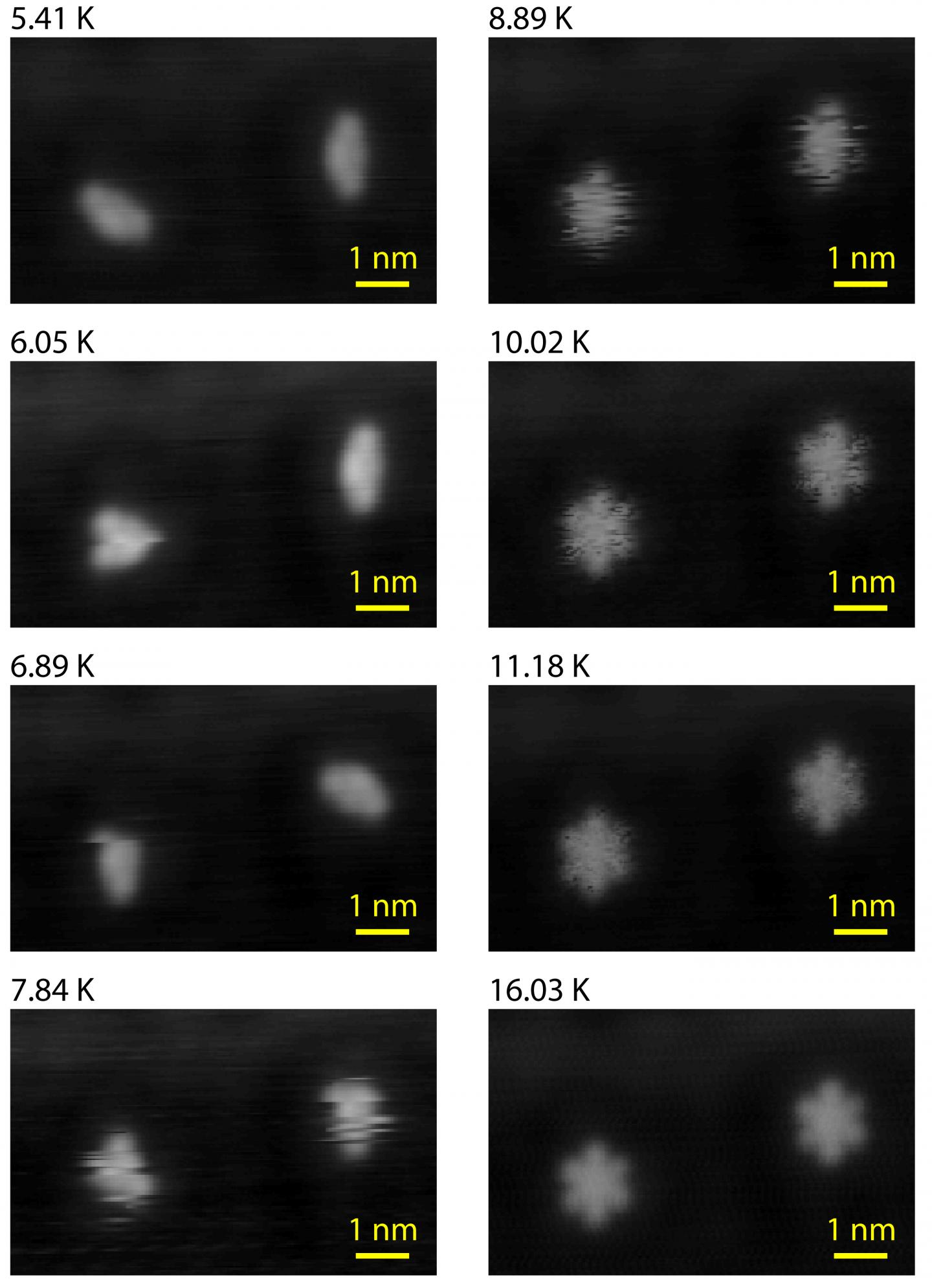
Credit: J.C. Gehrig, EMPA
New research shows that a scanning-tunneling microscope (STM), used to study changes in the shape of a single molecule at the atomic scale, impacts the ability of that molecule to make these changes. The study, appearing this week in the journal Nature Communications, demonstrates that the position of the tip of the STM relative to the molecule changes the energy requirements of the molecule to make changes in shape, and in turn, changes the entropy of the system.
"Entropy is often thought of as a measure of disorder or randomness, but here it is determined by the number of shapes that the molecule could potentially take, as well as by the number of different ways that the molecule could meet the energy requirements to change its configuration," said Eric Hudson, associate professor of physics at Penn State and an author of the paper. "If the tip of the STM increases the energy required by the molecule to make a change in shape, it is also increasing entropy in the system. In essence, a transition requires a potentially large number of small-energy excitations to co-occur to overcome the energy barrier for a configuration change. The larger the number of excitations required, the more ways in which those excitations may be collected. This multiplicity gives rise to entropy."
"That was totally unexpected," said Hans Joseph Hug, professor of physics at EMPA, the Swiss Federal Laboratories for Materials Science and Technology and an author of the paper. "It meant that the tip — which is still relatively far away from the molecule and in no-way touches it — somehow influences the molecule's mobility."
The rate at the which the molecule "hops" between shapes and the number of possible different shapes that the molecule can take — a representation of the molecule's entropy — changes depending on the distance between the tip of the STM and the molecule. "This means that the instrument we are using is affecting the system we are trying to study," said Hudson. "But more importantly, it allows us to measure the molecule's entropy and the fundamental relationship between entropy and the energy requirements of the molecule to make conformational changes."
The research team was interested in understanding what drives a molecule's ability to make changes to its shape — a common requirement of chemical reactions and biological processes. They used an STM, which consists of an extremely fine wire with a sharp tip that can be positioned with sub-atomic precision, to observe changes in the shape of a single molecule of dibutyl-sufide, a lengthy hydrocarbon with a central Sulphur atom, attached to a flat gold surface. Current passes between the tip of the STM and the surface and as the tip scans across the surface the STM detects changes in that current as it passes over the molecule. These changes in current are used to produce an image of the molecule.
"At extremely low temperatures — just a few degrees above absolute zero (-273 degrees Celsius or zero degrees Kelvin) — the molecule moves very slowly and the STM captures almost a still image of the molecule," said Hudson. "But as we raise the temperature even just a few degrees, the molecule moves faster and the image from the STM will show the molecule in more than one conformation. It's like taking a photograph of a moving object with a slow shutter speed."
The research team used the STM to observe the changes in shape of the dibutyl sulfide molecule at temperatures ranging from about 5 to 15 degrees Kelvin in order to understand the physical parameters that control the molecule's ability to change shape. There are two physical parameters that are typically used to describe how free to move a molecule on a surface is: the activation energy, the energy barrier it has to overcome to carry out the movement in question; and the attempt rate, how often the molecule tries to initiate the movement. Surprisingly, they noticed that the energy barrier for the molecule changed depending on the position of the STM tip, even at the same temperatures.
The team also observed that the molecule's attempt rate — which is related to the molecule's entropy — was also impacted by the position of the STM. "This implies that the energy and the entropy in this system are somehow linked at a fundamental level," said Hug. "What's more, our results imply that entropy plays a decisive role for the dynamics of the molecule even at very low temperatures where a molecule's degree of freedom, and thus its "configurational" entropy, are usually significantly reduced and entropy is considered to only play a minor role."
"In our study of dibutyl sulfide, the fascinating observation is that raising the hurdle for the molecule's change in shape — the energy barrier for the movement — simultaneously provides it with a greater number of pathways to overcoming it — an increase in entropy," said EMPA physicist Miguel A. Marioni, an author of the paper. "These findings imply that our home-built STM is a perfect tool for studying a single molecule's entropy in great detail."
"To me the thing that is coolest, is that entropy is this fundamental thing that we all learn about in school, but it's never something that you measure," said Hudson. "When you go in the lab it just disappears somehow, so that fact that we were able to measure it, and that the entropic forces are comparable to the forces we typically measure was just mind-blowing."
###
In addition to Hug, Marioni, and Hudson, the research team includes Jeffrey C. Gehrig, Marcos Penedo, Manfred Parschau, at Johannes Schwenk at EMPA. The research is funded by the Swiss National Science Foundation and EMPA.
CONTACT
Eric Hudson
[email protected]
+1-814-863-5345
Barbara Kennedy
[email protected]
+1-814-863-4682
Media Contact
Barbara K. Kennedy
[email protected]
814-863-4682
@penn_state
http://live.psu.edu
############
Story Source: Materials provided by Scienmag





